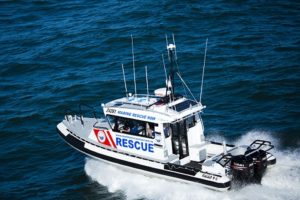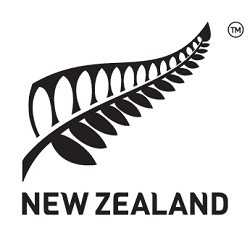It’s a story familiar to anyone with experience on the water: a boat overturns while crossing a bar at night. Rescuers motor to the vessel in stormy seas, wave after wave slapping their own hull.
The real-life drama was recounted to Naiad director John Cowan. The New Zealand brand builds rescue and other boats for organizations worldwide. It has more than 30 years’ experience custom-designing and  manufacturing large commercial rigid hull inflatable boats (RHIBs). Naiad pays special attention to configuring a hull shape providing a higher level of comfort at high speeds in rough conditions. This ensures crews can get to the rescue area faster to reduce the victim’s risk of drowning or hypothermia and increase their chances of being found.
manufacturing large commercial rigid hull inflatable boats (RHIBs). Naiad pays special attention to configuring a hull shape providing a higher level of comfort at high speeds in rough conditions. This ensures crews can get to the rescue area faster to reduce the victim’s risk of drowning or hypothermia and increase their chances of being found.
Naiad search and rescue boats
The incident Cowan recalled took place earlier this year in New Zealand, but could’ve happened anywhere. A rescue team member thanked Cowan for building such a safe boat. “He said, ‘I think if we’d been in anything else, we’d have certainly overturned.’”
It’s no accident Kiwi companies build some of the most capable search and rescue vessels in the world. You’re never more than 80 miles from the ocean anywhere in New Zealand. Its remoteness means seafarers for generations have needed to innovate ways to make marine travel faster and safer.
Cowan says the island nation “punches well above its weight” internationally. “There are some things that help us in New Zealand address challenges in designing boats and looking for solutions and that is the can-do attitude and a strong affinity for the sea.” Cowan says Kiwis enjoy the greatest participation per capita in boating and 95 per cent of the population lives within 30 miles of the ocean. “We have a close relationship with the sea and I think also people of my generation have been inspired by the success of America’s Cup.”
Naiad shares its inspiration and innovation with search and rescue crews worldwide, designing boats that can be customized to a user’s needs. “What makes Naiad’s boats attractive to search and rescue people is our boats are really tough and they’re great sea-keeping boats that can handle rough conditions. That’s important for people involved in rescue - they don’t get to choose when they go out. They’re called out often in bad conditions so attention to detail we put into the hull forms to give them that good, safe ride in rough conditions; it’s a major attraction to search and rescue operators.”
Another Kiwi company, HamiltonJet, designs and manufactures up to 20 different models of waterjet propulsion and control systems. HamiltonJet’s Global Marketing Manager Albear Montocchio says the business has been  providing waterjet solutions for the SAR sector worldwide for more than 40 years. “We have recently developed some advanced innovative products across our electronic waterjet control system that will give SAR operators more features such a position keeping, virtual anchoring or precision manoeuvring.” The company’s JETanchor product was designed to allow operators to use new automatic modes for many activities while reducing crew fatigue, increasing fuel efficiency and boosting safety.
providing waterjet solutions for the SAR sector worldwide for more than 40 years. “We have recently developed some advanced innovative products across our electronic waterjet control system that will give SAR operators more features such a position keeping, virtual anchoring or precision manoeuvring.” The company’s JETanchor product was designed to allow operators to use new automatic modes for many activities while reducing crew fatigue, increasing fuel efficiency and boosting safety.
HamiltonJet in action
HamiltonJet partners with rescue operators globally, including in the United States, where it has been involved with multiple builders including SAFE Boats’ Cutter boat Over The Horizon(CB-OTH) program. Montocchio says the OTH boats were built to strict U.S. Coast Guard specifications to ensure successful launch and recovery from a parent Cutter craft.
"SAFE Boats enjoy a storied history with America’s Coast Guard," says Scott Peterson, CEO of SAFE Boats International. "We are proud to extend our relationship with a cutter-launched boat that will operate at the cutting edge of the Coast Guard’s law enforcement and security operations."
Montocchio says New Zealand’s geographic isolation means the company must compete globally through innovation and great marine design. “New Zealanders have a strong heritage of ocean farers from the original Polynesian explorers who built their own vessels to today’s high achievers in commercial and recreational marine design and manufacture.”
Today, HamiltonJet continues providing propulsion solutions to a large range of boat builders and designers in North America and beyond. Waterjet propulsion is well accepted in the SAR sector thanks to high maneuverability, higher speed capability, greater safety (there’s no propeller to hurt people being rescued) and the ability to operate in very shallow water.
Search and rescue vessels must be tough, fast and nimble to help people in situations they hadn’t planned for like their boat running aground, taking on water, or getting caught in a storm. New Zealand innovators like Naiad and HamiltonJet are building customised solutions that save lives.
To learn more about New Zealand marine innovation + technology contact: [email protected] at New Zealand Trade and Enterprise.





